The Essential Guide to Crafting a Winning Creative Brief
What if you’re excited about the idea, you’ve set your KPIs, but the moment you hand over the brief, you see confusion, debate, and rework. That’s because a weak creative brief can sabotage even your best-performing campaigns.
When your team is unclear on the “what” and “why,” you waste time, blow budgets, and miss opportunities to scale winners. A strong brief should give clarity on goals, audience, tone, deliverables, and constraints. So, if you’re a creative strategist or UA manager dealing with vague briefs, endless revisions, or underperforming creatives, this blog is for you.
Here, you'll learn how to write a creative brief that is clear, data-driven, inspires your team, boosts ad performance, and turns insights into measurable growth.
Key Takeaways
A strong brief defines goals, audience, message, and tone to keep teams focused and campaigns effective.
Include essential elements like objective, target audience, creative direction, assets, and performance KPIs to ensure your brief acts as a roadmap.
Utilize deep insights from platforms like Segwise to craft creative briefs that offer actionable guidance on what actually works.
Avoid common mistakes like being too vague or too prescriptive. Instead, lean on Segwise creative analytics and fatigue tracking to make your briefs smarter and more agile from day one.
What Is a Creative Brief?
A creative brief is a clear, strategic document that outlines what your campaign aims to achieve, who it speaks to, and how it should look and feel. It provides your creative team the direction they need without telling them exactly what to design.
Here’s who usually creates campaign briefs:
Creative Strategist
Performance Marketer
Media Buyer
Marketing or Brand Manager
But understanding what a creative brief is only matters if you know why it’s so essential to your campaign’s success.
Also Read: Creative Tagging Tools That Can Boost Your Ad Campaign ROI in 2025
Why Are Briefs So Crucial?
A solid creative brief for your app campaigns is your foundation for measurable results. Here are key reasons why a creative brief matters for your team:
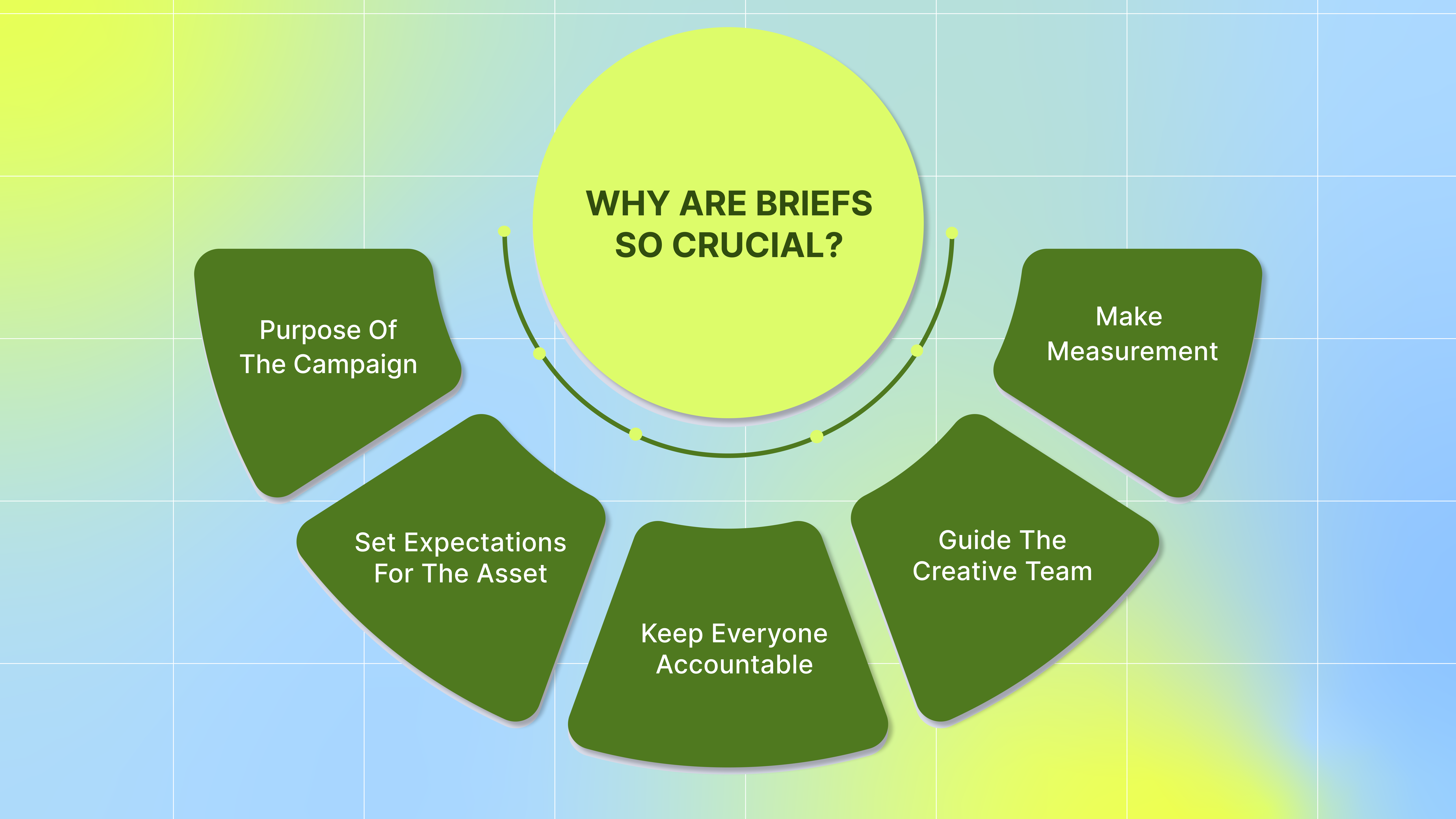
Clarify the purpose of the campaign: Know exactly why you’re running the ad and what success looks like. This helps your team prioritize creative decisions around a single, focused goal.
Set expectations for the asset: Define what the creative needs to achieve from format to messaging. This ensures your team delivers what’s needed, without back-and-forth.
Keep everyone accountable: Assign clear roles, responsibilities, and deadlines to all. That way, no one's left wondering who’s doing what or when.
Guide the creative team: Provide your designers and editors with the necessary input to execute their tasks effectively. Direction leads to stronger, faster output, not endless revisions.
Make measurement easier: Tie your creative brief to performance metrics like ROAS or CTR. This makes post-campaign analysis easier and more actionable.
You can tie your creatives in the brief to performance metrics like ROAS. For instance, Segwise links creative elements (hooks, scenes, and visuals) to ROAS so your brief can focus on what actually drives performance.
To turn that clarity into action, your brief needs a few key components.
Essential Elements of a Creative Brief
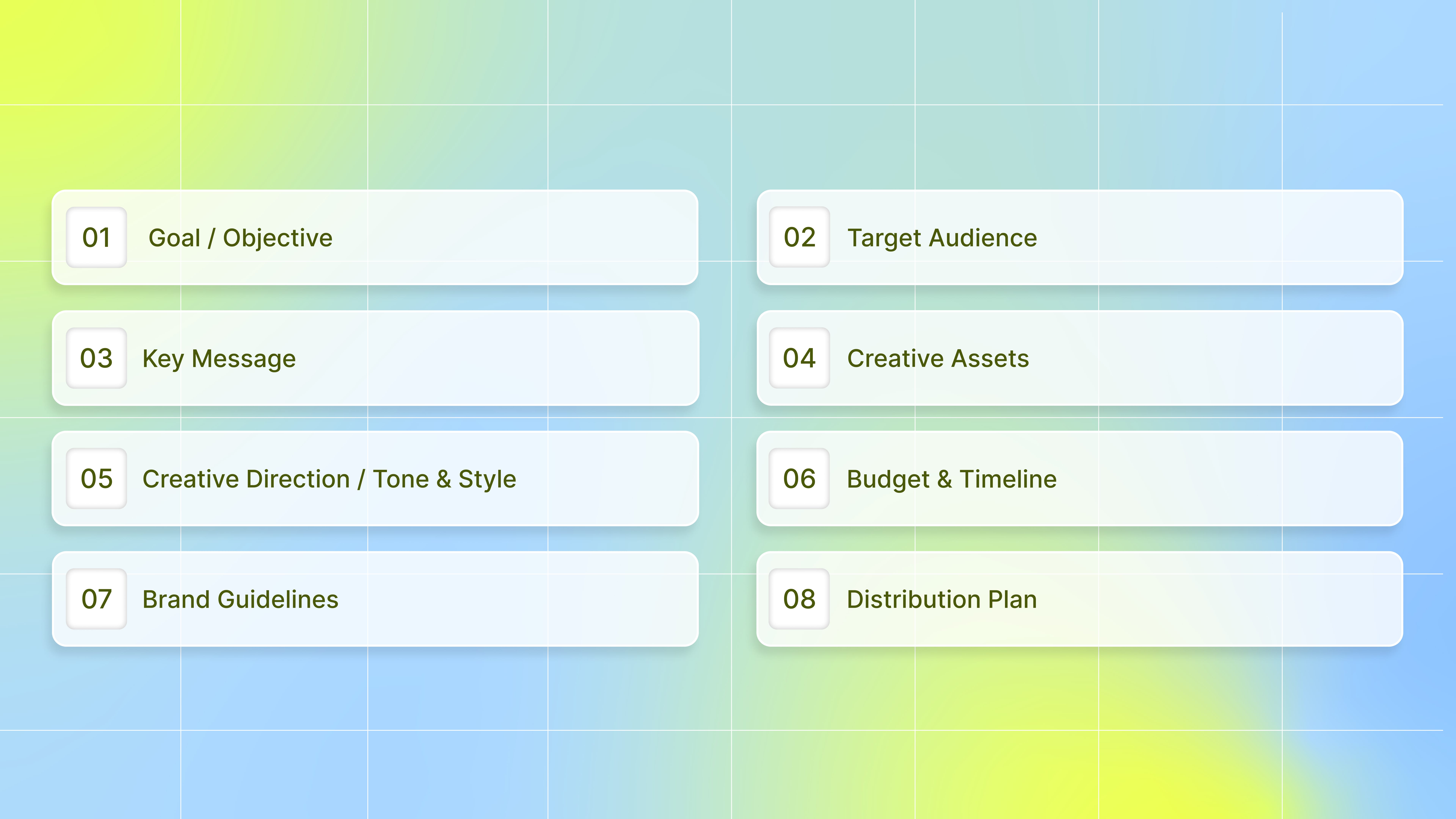
A strong brief gives your creative team clear guidance, eliminating guesswork. For mobile games, DTC brands, subscription apps, or agency campaigns, these elements help creatives deliver effective results quickly.
Here are the must‑have elements in your brief:
1. Goal / Objective
Define your campaign’s goal clearly, whether it’s driving app installs, boosting purchases, improving LTV, or testing a new product angle. A specific objective helps your creative and UA teams focus on results.
2. Target Audience
Who is the ad speaking to? Go beyond general demographics and dig into user behavior, motivations, pain points, and buying triggers. For example, is your audience first-time mobile gamers, or skincare-focused buyers?
3. Key Message
What is the one thing you want the user to remember or act on? Your message should be focused, bold, and tied directly to the campaign objective. For example, “Get glowing skin in 30 days”. Your message should spark action, not confusion.
With Segwise’s creative tagging, you can identify which message hooks (dialogues, visuals, CTAs) perform best. Then, you can embed those proven message formats into the brief.
4. Creative Assets
List all required assets, such as video ads, statics, carousels, playables, banners, or UGC, specifying variations and formats for each channel to help your creative team plan efficiently and minimize revisions.
5. Creative Direction / Tone & Style
What should the creative look and feel like? Define the mood (e.g., bold, friendly, aspirational), tone of voice (e.g., playful, serious, direct), and any visual elements to use or avoid. You can include inspiration ads, style references, and brand do’s and don’ts.
6. Budget & Timeline
Specify how much you’re investing and when you need assets delivered. Include key milestones. This helps everyone stay aligned and prevents last-minute chaos that can delay launches.
7. Brand Guidelines
Include any brand assets or rules that must be followed, like fonts, colors, logo usage, taglines, or voice rules. If you have a brand kit, link to it. This ensures your creative stays consistent with your overall brand identity while adapting to the channel.
8. Distribution Plan
Outline where and how your creative campaigns will run. List channels (e.g., Facebook, TikTok, YouTube, programmatic), placements (e.g., Stories, Reels, Playable), and any targeting notes. This helps your creative team tailor visuals and copy for each platform.
With Segwise dashboards, you can aggregate performance data across ad networks and placements. This allows you to select channels and formats based on data and specify in the brief where each asset should be displayed.
Once you know what to include, the next step is putting it all together effectively.
Steps of developing creative briefs
A winning ad starts with a clear, focused brief. Whether you're launching a new game or testing subscription offers, your brief is what turns strategy into results. Here’s how to build one that actually helps your team launch better, faster, and more profitably:
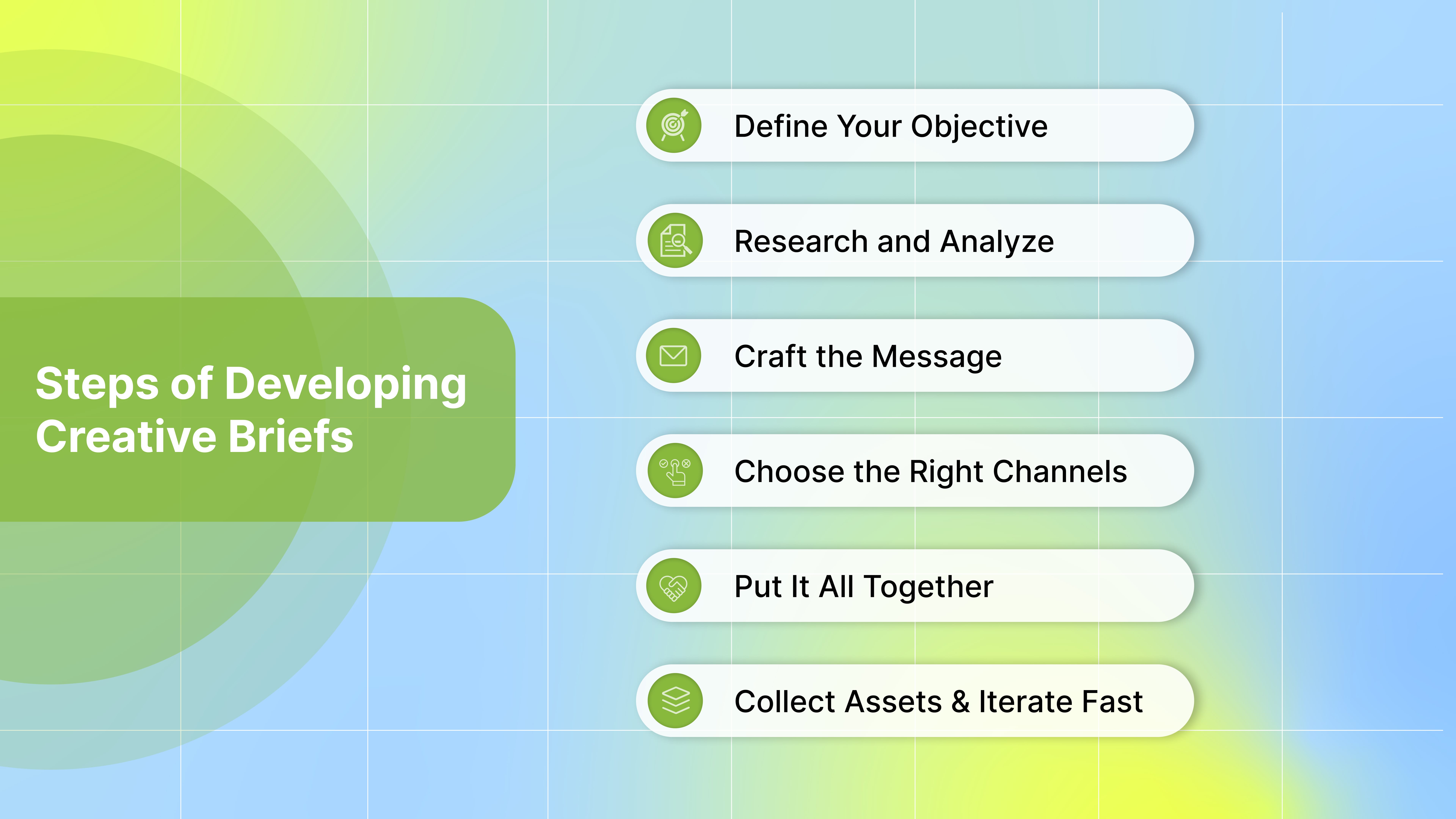
Step 1: Define Your Objective
The first step is clarity. What exactly are you trying to achieve? Your objective guides every creative decision that follows. Without it, you risk producing content that looks good but doesn’t deliver results. Here is how you can do this:
Identify the campaign’s purpose
Are you driving installs or retargeting churned users, or testing new audience segments? Define what success looks like for this campaign.
Align with business goals
Ensure the campaign’s objective directly connects to the company's or KPIs, such as ROAS targets, cost per install (CPI), or subscription upgrades.
Define your target audience
Who are you speaking to? Outline key demographics (age, region, gender), interests, motivations, and pain points. A well-defined audience ensures your creative message resonates and converts.
Clear, measurable goals help your team build with purpose and execute your campaign smoothly.
Step 2: Research and Analyze
Before writing your brief, gather insights that will make your campaign more innovative and more relevant. Research separates great briefs from average ones.
Conduct market research
Conducting market research is essential to creating a truly impactful marketing campaign. Study trends within your vertical, from the latest playable ad styles in gaming to top-performing UGC videos in DTC. Understand what’s capturing attention and why.
Use the Segwise custom dashboard to focus on your specific KPIs and needs and see how creative decisions impact ROAS across all your apps and campaigns.
Analyze competitors
While conducting market research, it's crucial to analyze your competition. Review how your competitors position themselves. What types of creatives, hooks, or CTAs are they using?
Identify key insights
Analyze data patterns to see what resonates with humor, short copy, or specific visuals. See what worked and what didn’t in previous campaigns. Pull creative-level insights from platforms such as Segwise dashboards. If CTR is high but conversions are low, focus your brief on stronger CTAs and clearer product messaging. Use findings to shape tone, direction, and testing.
Pro tip: Use Segwise’s Creative Analytics to pinpoint which elements like dialogue, product demo scenes, or color tones actually drive ROAS before writing your next brief.
Step 3: Craft the Message
Once you understand your audience and objectives, it’s time to decide what your ad should say and how it should say it. This is where strategy meets storytelling.
Key Message
What’s the one idea your audience should remember after seeing your ad? Keep it focused and outcome-oriented. Example: “This skincare brand helps you see results in 14 days.”
USP (Unique Selling Proposition)
To make your marketing or advertising campaign stand out, it's crucial to develop a unique selling proposition (USP). What makes your brand, product, or offer different from competitors?
Tone of Voice
The tone of voice in your ad copy plays a significant role in capturing your audience's attention. Select the angle that best suits your audience: playful, bold, aspirational, or trustworthy. Match the tone to the platform (e.g., witty for TikTok, polished for YouTube).
A focused message with a strong emotional hook will always outperform a generic one. Use Segwise Tagging insights to see which messaging elements (like “first 30 days free” or “watch-to-win”) historically deliver better CTR and build your brief around them. The goal is to create a concise, persuasive message that inspires immediate action, installs, purchases, or sign-ups.
Step 4: Choose the Right Channels
Even the best creative message will fail if it’s delivered in the wrong place. Choosing the right channels ensures your ads reach the right audience in the right format at the right time.
Know where your audience hangs out
Understand where your target audience spends most of their time. Are they scrolling through TikTok, searching on YouTube, or exploring the App Store? Each platform attracts a different mindset, and your creative should match that behavior.
Evaluate your options
Each advertising platform has its own strengths, formats, and targeting tools. Compare cost efficiency, audience targeting, and creative flexibility before committing to spend..
Pick the best fit
Choose channels where your creative feels natural. Native-looking ads outperform forced ones. Tailor content for each platform, quick hooks for TikTok performance visuals, or for Meta to boost engagement, CTR, and results.
By choosing the right channels early, you save production time, maximize ROI, and ensure your creative is optimized for performance from the start.
Step 5: Put It All Together
It’s time to turn your research and ideas into a working brief.
Write a clear and concise creative brief
Bring all key components together: campaign objective, target audience, messaging, creative direction, deliverables, timeline, and KPIs. Keep it focused and easy to read.
Share it with your team
Distribute the brief to everyone involved, including designers, media buyers, and UA leads. Make sure each stakeholder understands their role, expectations, and timelines. Alignment at this stage prevents miscommunication and delays later.
Review and refine
Don’t treat the brief as a static document. Gather feedback from your team, and adjust based on performance data, creative constraints, or changing goals. Iterating your brief just like your ads helps ensure the end product stays relevant and effective.
A great brief saves time, reduces revisions, and keeps your campaign on track.
Pro tip: Use Segwise dashboards to attach creative examples and performance data directly in your briefs so your team sees data behind every decision.
Step 6: Collect Assets & Iterate Fast
Your creative brief is only valuable if it leads to fast, informed execution. To maximize performance, you need a smooth asset workflow and a culture of ongoing testing and iteration.
Asset Submissions & Review
Use a centralized platform to collect creatives, share feedback, and approve assets. This keeps everything organized and avoids scattered conversations.
Test new hooks and CTAs regularly
Don’t stick to one message or visual rotate hooks, headlines, intros, and CTAs across channels. Testing different angles helps identify what resonates with each audience.
With Segwise Experiment Tracking, you can monitor A/B tests, insight-based creatives, and optimization experiments systematically.
Use insights to double down
Once your ads are live, track performance (CTR, IPM, ROAS) using tools like Segwise. Focus on top-performing elements, drop underperformers, and use these insights for your next brief.
Even with a solid process, it’s easy to run into common mistakes that can derail your brief.
The Common Pitfalls of Creative Briefs
When you launch a campaign without a solid brief, you risk wasting your budget, creating misaligned creative, and enduring endless revisions. The best teams avoid mistakes before they start.
Here are the common pitfalls that often derail creative briefs:
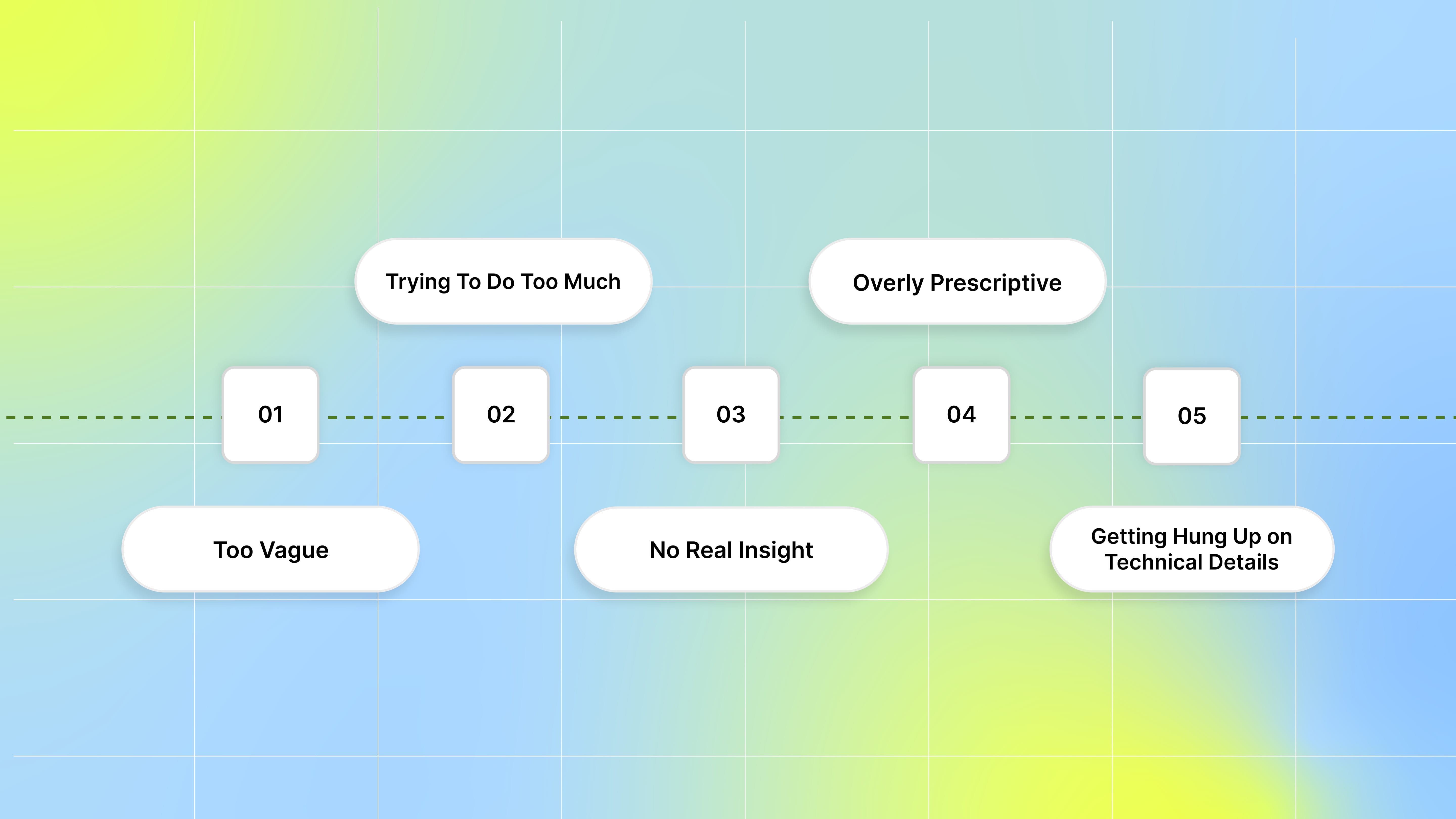
Too vague: A brief without a clear direction forces your creative team to fill in the blanks. This often leads to guesswork and misinterpretation.
Trying to do too much: If you stack 3 or 4 objectives or messages in one brief, none will land effectively. Your creativity ends up diluted and confusing.
No real insight: A brief with facts but no human insight, like pain points, desires, or emotional triggers, won’t inspire performance-driven ideas.
Overly prescriptive: Micromanaging every detail of the creative, like specifying shot order, background colors, or exact copy, can suffocate creativity.
Getting hung up on technical details: While specs and formats matter, focusing too early on aspect ratios, file sizes, or render times can distract from the creative message.
Segwise helps you avoid these pitfalls by grounding your briefs in performance data. With AI-powered creative tagging and creative analytics, it eliminates guesswork, provides deep insights, and helps you focus on the creative elements that actually drive ROAS.
Avoiding mistakes is just the start. Here’s how to get your briefs right from the beginning.
Best Practices for Writing an Effective Creative Brief
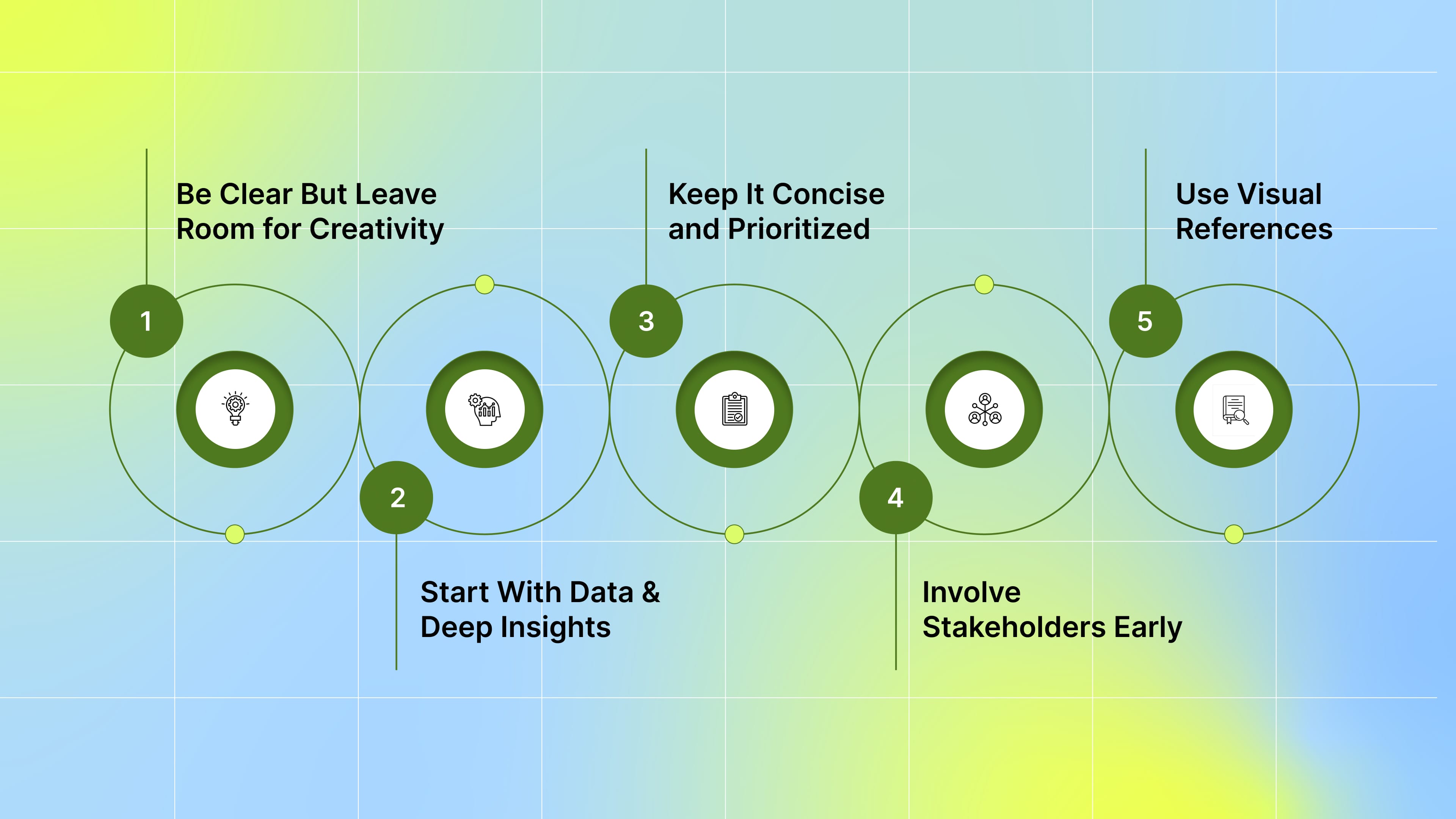
A good brief sets direction, frees creativity, and speeds execution, especially when you need your creatives to work quickly and thoroughly test their ideas.
Here are the best practices:
Be clear but leave room for creativity: Define your goal, audience, and message, but avoid micromanaging. Give your creative team room to deliver strategic, original ideas.
Start with data & deep insights: Use past campaign data, research, and audience insights to shape your brief. It gives the creative team substance, not fluff.
Keep it concise and prioritized: Resist the urge to overload the brief. Focus on what truly matters (objective, key message, channels, metrics) and avoid irrelevant details that distract.
Involve stakeholders early: Bring in creative, media, analytics, and leadership when drafting the brief. That alignment up front reduces conflicting feedback later and ensures everyone is involved.
Use visual references and examples: Don’t rely only on text. Share mood boards, competitor ads, reference videos, and visuals to help creatives understand the “feel” you’re aiming for.
Also Read: Why Creative Tagging Matters for Mobile Game Marketers in 2025
Conclusion
A strong creative brief drives focused execution, faster testing, and better-performing campaigns. It aligns your team, reduces confusion, and helps you scale what works. From clear objectives to audience targeting, messaging, and distribution, each element helps your creative hit the mark and drive results that matter.
That’s where Segwise comes in. By leveraging AI‑powered creative analytics and tagging, Segwise helps you move beyond guesswork and base your briefs on deep insights. You’ll know which creative elements drive ROAS, which hooks resonate with your audience, and which formats perform best.
Here are some of the key ways Segwise helps you write better creative briefs and run stronger campaigns:
Segwise’s powerful multi-modal AI automatically identifies and tags creative elements, such as hook dialogues, characters, colors, and audio components, across images, videos, text, and playable ads.
This means you gain clear insights into which creative elements drive performance (IPM, CTR, ROAS), rather than relying on guesswork.
Unified Creative Analytics for All Your Creative Data
Stop jumping between Facebook Ads Manager, Google Ads, TikTok, and your MMP dashboard. Segwise brings creative-level ROAS, CPA, LTV, and conversion rates from all sources into a single, unified view.
This means you can say things like, “Hook A + Character B delivered 20% better ROAS,” and use that insight to write your briefs around what actually works.
Tag‑Level Creative Element Mapping
Segwise shows you which specific creative elements drive performance, for example, “this hook dialogue appears in 80% of our top‑performing creatives.”
This means your creative brief can include real, proven elements (e.g., “use character‑driven hook + purple background”) rather than vague directives.
Custom Dashboards, Reporting & Multi‑Project View
Build dashboards around key KPIs and stakeholder needs. Automate reports to show how creative choices affect ROAS across apps and campaigns. With a multi-project view, you can track performance consistently and back briefs with data-driven insights.
For a creative or UA lead, this means your brief can reference deep data dashboards and trends, making it more credible and actionable.
Creative Fatigue Tracking & Alerting
Segwise tracks creative performance across channels, alerting your team to drops before your budget is depleted.
This means you can include fatigue‑related rules or success criteria in your brief (e.g., “pause after 7 days or 100K impressions”) and keep your campaign agile.
Together, these features transform Segwise into a strategic engine for creative briefs that reference top-performing elements and guide your team to act and scale.
So, are you ready to upgrade your creative process? Start your free trial today and begin crafting briefs that fuel real growth.
FAQs
1. How long should a good creative brief be?
A strong brief is concise, often one to two pages. It covers key elements like objective, audience, message, assets, and budget, without overloading with unnecessary detail.
2. How should you use data in a creative brief?
Use past campaign metrics, audience behavior, and creative element performance (e.g., hooks, visuals) to shape your brief. This provides insight-driven direction rather than relying on assumptions.
3. How often should I revisit and update my creative brief?
Whenever the campaign objective shifts, audience changes, or performance data reveals new insights, you should update your brief. Treat it as a live document, not a one‑time task.
